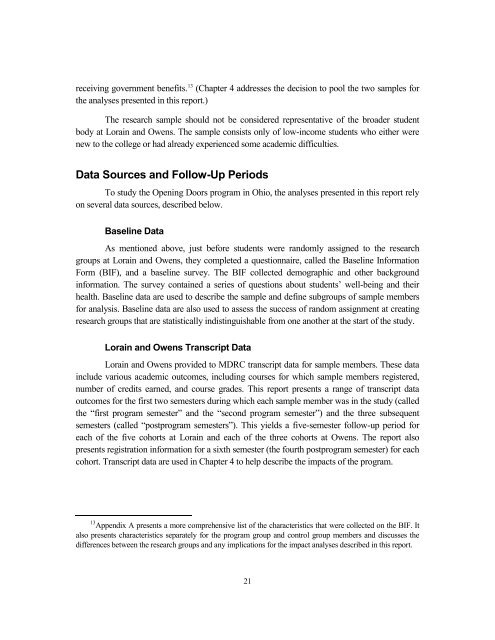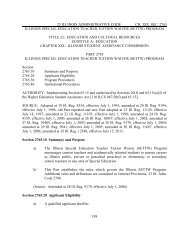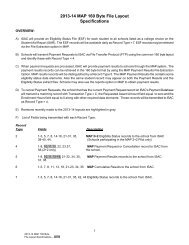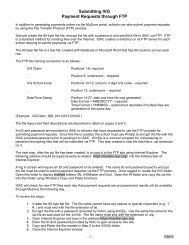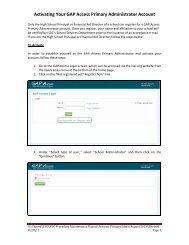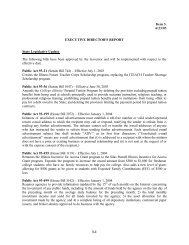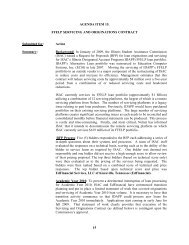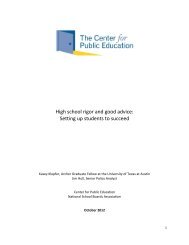Table 2.1 (continued)SOURCE: MDRC calculations using Baseline Information Form (BIF) data.NOTES: Rounding may cause slight discrepancies in sums and differences.A two-tailed t-test was applied to differences between the two groups of sample members. Statisticalsignificance levels are indicated as: *** = 1 percent; ** = 5 percent; * = 10 percent.aRespondents who indicated that they are Hispanic and who chose a race are included only in theHispanic/Latino category.b“Other race” includes American Indians/Alaskan Natives and those who marked “other race/ethnicity” ormore than one racial/ethnic category.cBenefits include Unemployment/Dislocated Worker benefits, Supplemental Security Income (SSI) ordisability, cash assistance or welfare, food stamps, and Section 8 or public housing.dDistributions may not add to 100 percent because categories are not mutually exclusive.eThis category includes the Baltics, the Commonwealth of Independent States, eastern and western Europe,North Africa, Sub-Saharan Africa, the Near East, and Oceania. The Commonwealth of Independent Statesincludes Armenia, Azerbaijan, Belarus, Georgia, Kazakhstan, Kyrgyzstan, Republic of Moldova, Russia,Tajikistan, Turkmenistan (until August 2005), Ukraine, and Uzbekistan. Countries are grouped by regionaccording to the U.S. Bureau of the Census, International Data Base.fThe majority of respondents reported that both parents were born in the same region as each other.most were unmarried. The sample members who were parents had an average of two children,and many of the children were young: the average age of the sample members’ youngest childwas about 3 years (not shown in Table 2.1).Only 18 percent of the sample members reported that they were financially dependenton their parents. Just over half were employed when they entered the study and just under halfsaid that someone in their household received government benefits designed for people livingbelow the federal poverty level.Roughly a third of the sample members were the first in their family to attend college.Almost three-fourths said that their main reason for enrolling in college was to obtain anassociate’s degree or to transfer to a four-year college or university.In addition to presenting the characteristics of the pooled sample, Table 2.1 presents thecharacteristics of the sample members from each college. An asterisk in the rightmost columnof the table indicates that the difference between the proportion of sample members from Lorainwith the given characteristic and the proportion of sample members from Owens with thatcharacteristic is statistically significant (meaning that the difference is unlikely to be due tochance). As the table shows, the samples are quite different. Compared with sample members atOwens, sample members from Lorain are more likely to be women, older, married, and parents.They are less likely to be financially dependent on their own parents and more likely to be20
eceiving government benefits. 13 (Chapter 4 addresses the decision to pool the two samples forthe analyses presented in this report.)The research sample should not be considered representative of the broader studentbody at Lorain and Owens. The sample consists only of low-income students who either werenew to the college or had already experienced some academic difficulties.Data Sources and Follow-Up PeriodsTo study the Opening Doors program in Ohio, the analyses presented in this report relyon several data sources, described below.Baseline DataAs mentioned above, just before students were randomly assigned to the researchgroups at Lorain and Owens, they completed a questionnaire, called the Baseline InformationForm (BIF), and a baseline survey. The BIF collected demographic and other backgroundinformation. The survey contained a series of questions about students’ well-being and theirhealth. Baseline data are used to describe the sample and define subgroups of sample membersfor analysis. Baseline data are also used to assess the success of random assignment at creatingresearch groups that are statistically indistinguishable from one another at the start of the study.Lorain and Owens Transcript DataLorain and Owens provided to MDRC transcript data for sample members. These datainclude various academic outcomes, including courses for which sample members registered,number of credits earned, and course grades. This report presents a range of transcript dataoutcomes for the first two semesters during which each sample member was in the study (calledthe “first program semester” and the “second program semester”) and the three subsequentsemesters (called “postprogram semesters”). This yields a five-semester follow-up period foreach of the five cohorts at Lorain and each of the three cohorts at Owens. The report alsopresents registration information for a sixth semester (the fourth postprogram semester) for eachcohort. Transcript data are used in Chapter 4 to help describe the impacts of the program.13 Appendix A presents a more comprehensive list of the characteristics that were collected on the BIF. Italso presents characteristics separately for the program group and control group members and discusses thedifferences between the research groups and any implications for the impact analyses described in this report.21
- Page 1: OPENING DOORSMORE GUIDANCE,BETTER R
- Page 4 and 5: Funders of the Opening Doors Projec
- Page 7 and 8: ContentsOverviewList of Tables, Fig
- Page 9 and 10: List of Tables, Figures, and BoxesT
- Page 11: PrefaceIf approved by Congress, the
- Page 14 and 15: guidance on the study. Thomas Brock
- Page 16 and 17: • The Ohio colleges successfully
- Page 18 and 19: Program group members were assigned
- Page 20 and 21: • For the most part, the program
- Page 22 and 23: offered, but might also provide stu
- Page 25 and 26: Chapter 1IntroductionOver the last
- Page 27 and 28: The Opening Doors DemonstrationTabl
- Page 29 and 30: sure that students complete the req
- Page 31 and 32: While the mechanism through which s
- Page 33 and 34: imately 1,700 to 1 in 2001. 22 Exac
- Page 35: of literature exist on career couns
- Page 38 and 39: The CollegeLorain County Community
- Page 40 and 41: • Were beginning freshmen or cont
- Page 42 and 43: The Opening Doors DemonstrationTabl
- Page 46 and 47: Lorain and Owens Financial Aid Data
- Page 49 and 50: Chapter 3The Implementation of the
- Page 51 and 52: Toward the end of each student’s
- Page 53 and 54: meet with their counselor a minimum
- Page 55: The Opening Doors DemonstrationTabl
- Page 59 and 60: Appendix Table C.2 shows informatio
- Page 61: Opening Doors counselors, and progr
- Page 64 and 65: Program Control Difference Standard
- Page 67 and 68: Chapter 4The Effects of Enhanced St
- Page 69 and 70: Program SemestersTable 4.1 (page 47
- Page 71 and 72: Program Control Difference Standard
- Page 73 and 74: Program Control Difference Standard
- Page 75 and 76: The Opening Doors DemonstrationTabl
- Page 77 and 78: Transcript Outcomes by GenderAssess
- Page 79 and 80: Program Control Difference Standard
- Page 81 and 82: Program Control Difference Standard
- Page 83 and 84: correspond with the program’s imp
- Page 85 and 86: Chapter 5Summary and ConclusionsLor
- Page 87 and 88: The Opening Doors DemonstrationFigu
- Page 89 and 90: An alternative interpretation of th
- Page 91: Appendix ASupplementary Baseline In
- Page 94 and 95:
Full Program ControlCharacteristic
- Page 96 and 97:
Appendix Table A.1 (continued)Full
- Page 98 and 99:
Full Program ControlCharacteristic
- Page 100 and 101:
Appendix Table A.2 (continued)Full
- Page 102 and 103:
Appendix Table A.3 (continued)Full
- Page 105:
Appendix BSurvey Response Analysis
- Page 108 and 109:
Background Characteristics of Surve
- Page 110 and 111:
Table B.1 (continued)Characteristic
- Page 112 and 113:
The Opening Doors DemonstrationAppe
- Page 114 and 115:
Table B.2 (continued)SOURCE: MDRC c
- Page 116 and 117:
Table B.3 (continued)Characteristic
- Page 118 and 119:
The Opening Doors DemonstrationAppe
- Page 120 and 121:
Table B.4 (continued)SOURCE: MDRC c
- Page 122 and 123:
Table B.5 (continued)Characteristic
- Page 124 and 125:
The Opening Doors DemonstrationAppe
- Page 126 and 127:
Table B.6 (continued)SOURCE: MDRC c
- Page 129 and 130:
Lorain OwensProgram ProgramOutcome
- Page 131 and 132:
Lorain County Community CollegeOwen
- Page 133:
Appendix DDescription of Scales Pre
- Page 136 and 137:
4. I hardly ever expect things to g
- Page 138 and 139:
Social Support and Civic Engagement
- Page 140 and 141:
Psychological Distress (6-item summ
- Page 143 and 144:
Lorain County Community CollegeOwen
- Page 145 and 146:
Lorain County Community CollegeOwen
- Page 147 and 148:
Lorain County Community CollegeOwen
- Page 149 and 150:
Male SubgroupFemale SubgroupDiffere
- Page 151 and 152:
Male SubgroupFemale SubgroupDiffere
- Page 153 and 154:
Male SubgroupFemale SubgroupDiffere
- Page 155 and 156:
Lorain County Community CollegeOwen
- Page 157 and 158:
Appendix Table E.7 (continued)SOURC
- Page 159 and 160:
Lorain County Community CollegeOwen
- Page 161 and 162:
The Opening Doors DemonstrationAppe
- Page 163 and 164:
Appendix Table E.10 (continued)SOUR
- Page 165 and 166:
ReferencesAdelman, Clifford. 2004.
- Page 167 and 168:
EARLIER MDRC PUBLICATIONS ON OPENIN
- Page 169:
About MDRCMDRC is a nonprofit, nonp


